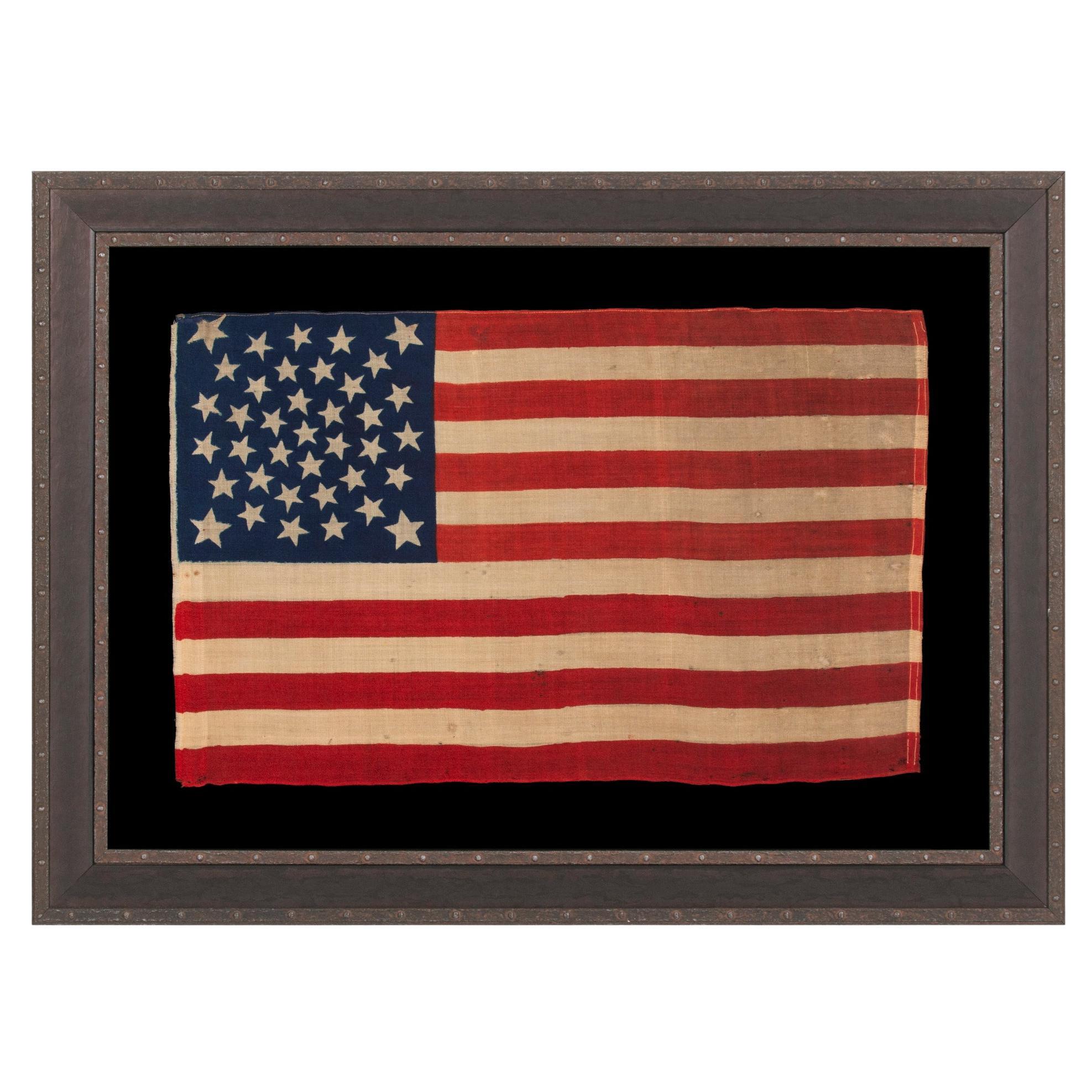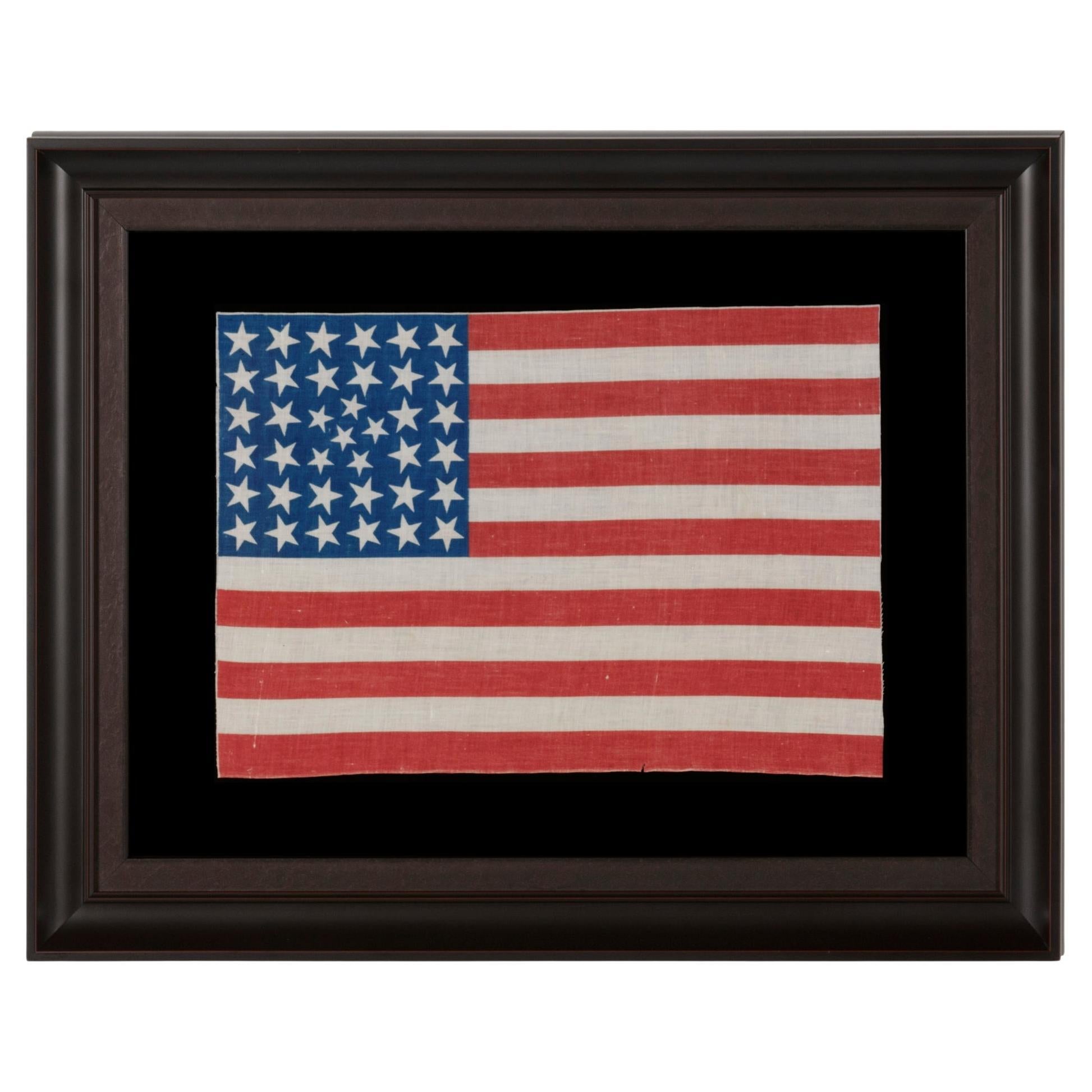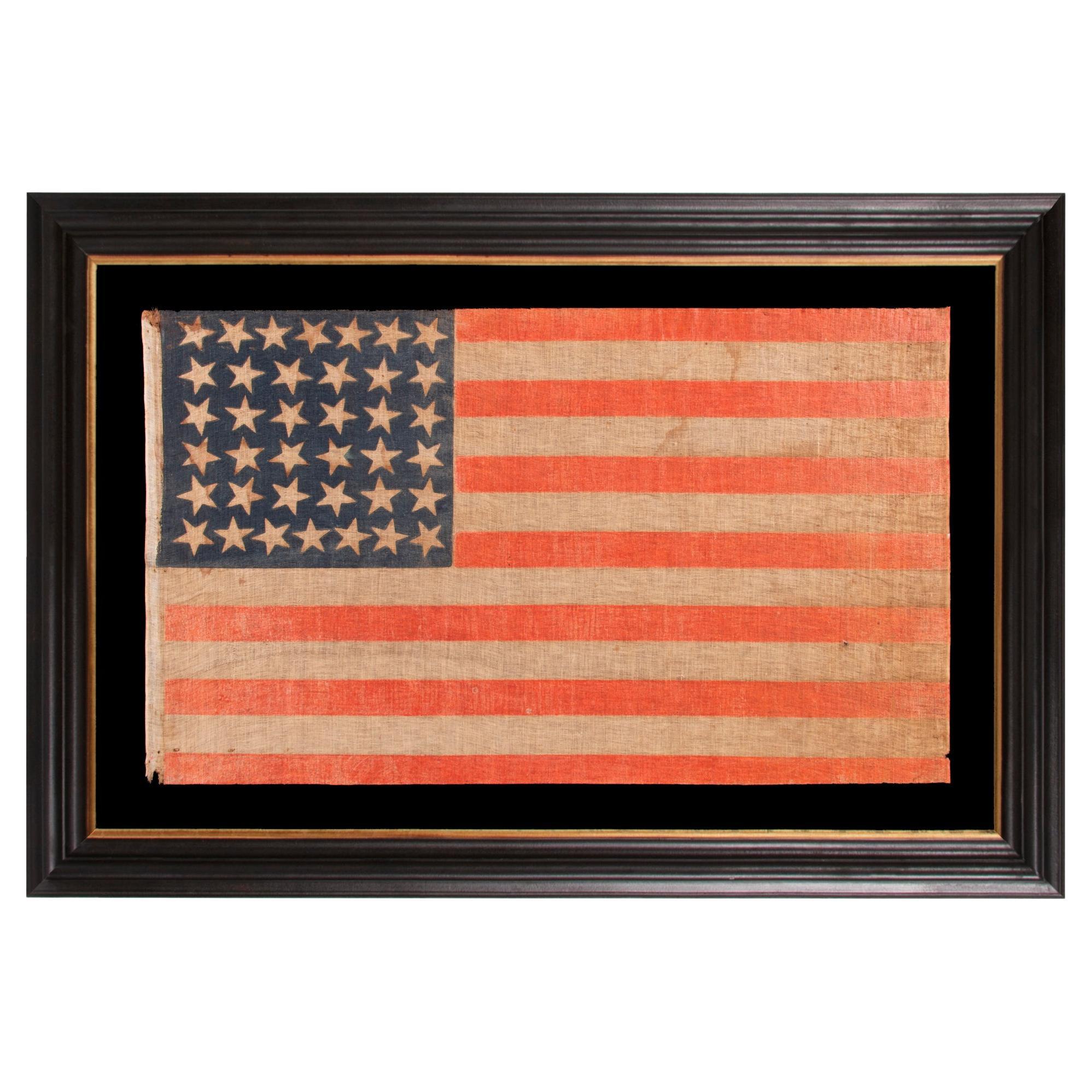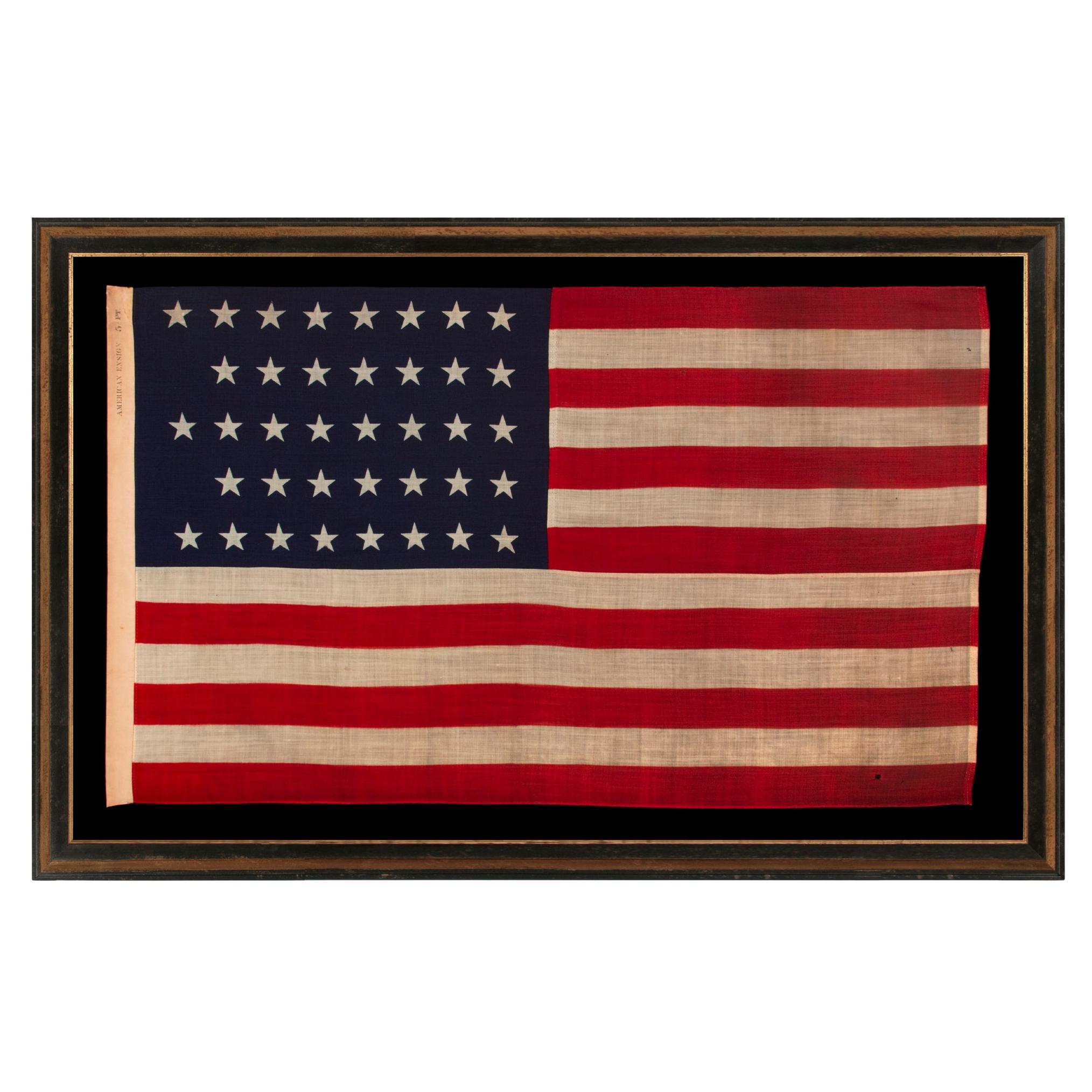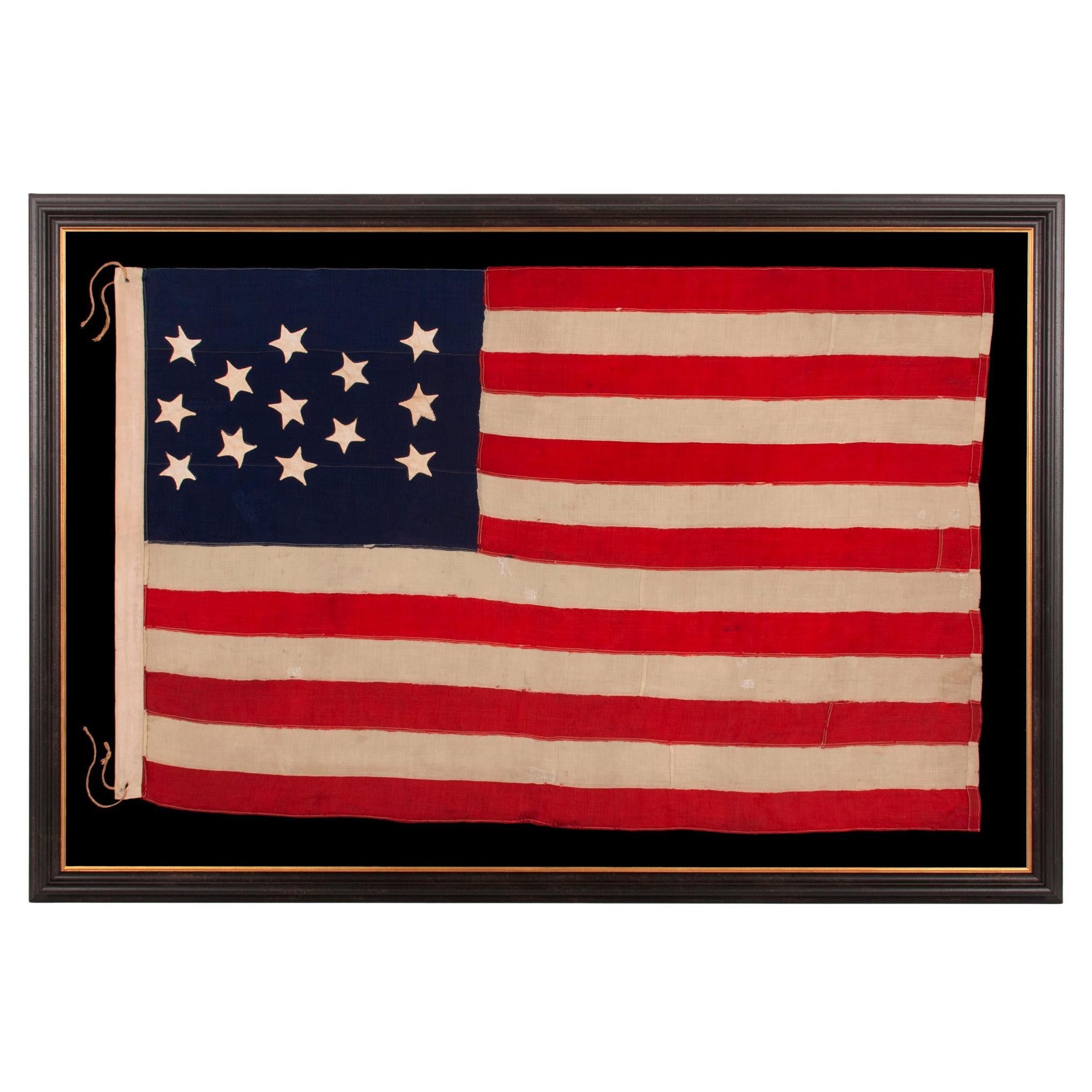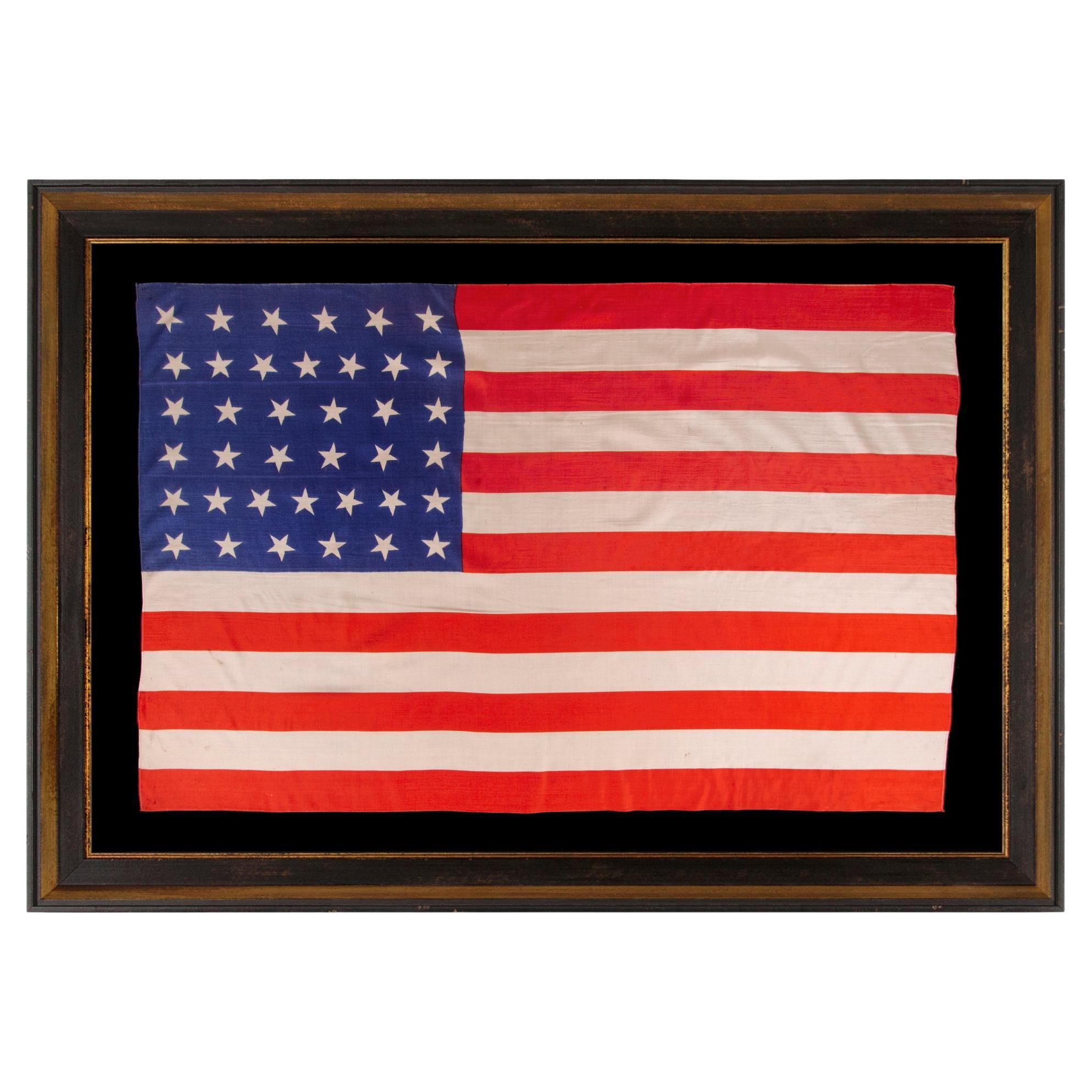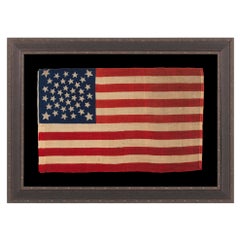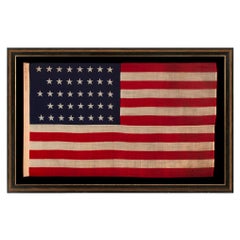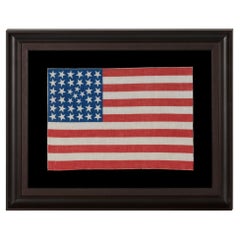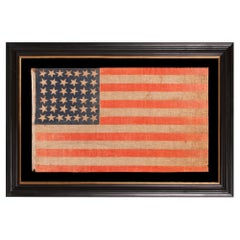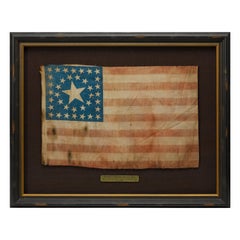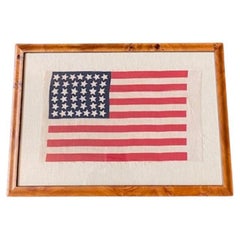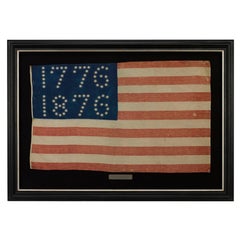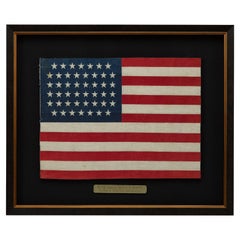Articoli simili a 38 Star Rare Circle in A Square Horstmann Brothers Made American Flag, ca 1876
Vuoi altre immagini o video?
Richiedi altre immagini o video al venditore
1 di 5
38 Star Rare Circle in A Square Horstmann Brothers Made American Flag, ca 1876
Informazioni sull’articolo
38 STARS IN A RARE AND STRIKING CIRCLE-IN-A-SQUARE MEDALLION, WITH AN ENORMOUS CENTER STAR, MADE FOR THE 1876 CENTENNIAL CELEBRATION BY HORSTMANN BROTHERS OF PHILADELPHIA, A MAJOR MILITARY OUTFITTER
38 star American national parade flag, press-dyed on wool bunting, with an especially rare type of medallion star pattern that consists of a huge center star, surrounded by a wreath of stars, with a square of stars around the perimeter. This design is significantly more rare than the equally beautiful “great star” pattern (a star made out of stars), generally thought of as the Rolls Royce of configurations among 19th century designs. Circle-in-a-square patterns are so scarce that even major collectors like Boleslaw Mastai, who wrote the first major text on flag collecting and owned more than 600 flags and flag-related objects, was evidently never fortunate enough to acquire one.
Many fantastic star patterns were made in the patriotism that accompanied or nation’s 100-year anniversary of independence in 1876 and this is among the best of all examples. Note how the vertical alignment of the stars varies greatly, but that the center star, as well as the stars in the left and right columns, all have one point directed upright. There were no regulations concerning either star configuration or position until 1912, and many flag-makers went out of their way to catch the attention of potential buyers.
The flag was made by Horstmann Brothers, a major Civil War military outfitter. I have owned examples of this precise and extremely scarce variety, on which the Horstmann name was printed. Due to the fact that the company was located in Philadelphia, and that the Centennial International Exposition—our nation's first major World’s Fair, which served as the nucleus of the national celebration—took place in the same city, in 1876, it is logical to assume that Horstmann supplied these flags to be displayed there. Photos of them, actually in use at the Expo, survive from two locations, one in a fan of flags (3 displayed) emerging from a patriotic shield, just to the left of the pavilion of Philadelphia map and print publisher Augustus Mitchell, high up on post #Q78, in the Main Building, and another from within the display of the AM District Telegraph Company (2 displayed, precise location unknown).
Note the attractive, royal blue color of the canton. Most known Horstmann examples in this rare design have much darker coloration. Sometimes there is a formal binding along the hoist of this style of flag, and sometimes not. In this case, both the hoist and fly ends are simply hemmed with treadle stitching. A series of small tack holes along the hoist, with small, associated rust stains, demonstrates how it was affixed to a wooden staff, with metal tacks.
Press-dyed wool flags are scarcer than those printed on cotton and silk. Because parade flags were often intended for one day's use at a parade, political rally, a reunion of soldiers, or some other patriotic event, most were made of cotton. While cotton absorbs water, short-term use precluded the need for anything more hardy. Because the Centennial Exposition lasted for a period of six months, it required decorative flags that would sustain being flown for a longer time and withstand the elements. Because wool sheds water, it was the fabric of choice selected by flag-makers for extended outdoor use. Prior to this time, press-dyed wool flags primarily served military function. With the advent of lengthy World’s Fair events in America, they were well-suited for the long-term, decorative applications these required and adapted as such.
Colorado became the 38th state on August 1st, 1876. This was the year of our nation’s 100-year anniversary of independence. Per the Third Flag Act of 1818, stars were not officially added until the 4th of July following a state's addition. For this reason, 37 was the official star count for the American flag in 1876. Flag-making was a competitive venture, however, and few flag-makers would have continued to produce 37 star flags when their competitors were making 38’s. It is for this reason that 38 and 13 stars (to represent the original 13 colonies) are more often seen at the Centennial Expo.
Some flag-makers would have been adding a star for the 38th state even before it entered the Union, in the early part of 1876 or even prior. In fact, many makers of parade flags were actually producing 39 star flags, in hopeful anticipation of the addition of two more Western Territories instead of one. But the 39th state would not join the Union for another 13 years, when the Dakota Territory entered as two states on the same day. The 38 star flag became official on July 4th, 1877 and was generally used until the addition of the Dakotas in 1889.
A Brief History of the Horstmann Company:
William H. Horstmann (1785-1850) was the founder of what would become a major military outfitter in both Philadelphia and New York City. A solider and fourth generation passementier (textile weaver), Horstmann emigrated to the United States from Cassel, Germany in either 1815 or 1816, settling in the Germantown area of Philadelphia, where there was a significant concentration of textile manufacturing. Horstmann established a business of manufacturing fringe, laces, and trimmings at 50 N. Third St. and soon after married the daughter of Frederick Hoeckly, the most successful lace manufacturer in the city. In 1824 he introduced three significant tools to America, including the first jacquard loom, for weaving multicolored fabrics, the first braiding machine, and a machine for plating metal. Moving to the corner of 59th & Third, he imported technology from Germany and elsewhere and maintained regular trade with his family in Europe. The company grew exponentially in size and had many addresses over its years of operation
In 1828, the William H. Horstmann Military Store opened and in 1831 he established a New York branch. In 1843 the name was changed to the William H. Horstmann & Sons Military Store, and in 1859 it was taken over by sons Sigmund H. and William J., who operated the business as Horstmann Bros. & Co. in both New York and Philadelphia. Taking on investors in the interim, from 1845-1849 it operated in NYC as Horstmann Sons & Drucker, then Horstmann Sons & Allien. As an outfitter of Civil War regiments, the firm manufactured its own goods, including flags, swords, drums, insignia, and many other items, and subcontracted for the manufacture of these objects as well, depending on financial sensibility. There were other investors and partners along the way, such as William S. Hassall and George Evans, who broke off and became a significant competitor as “Hassall & Evans.” Brothers Sigmund & William Horstmann passed in 1870 and 1872, respectively.
In 1877, the New York branch changed its name to that of partner H.V. Allien. In 1893 the Philadelphia location changed its name to simply “Wm. H. Horstmann Co.,” operating as such until 1940. In 1927 “Horstmann Uniform Co.” was established as a separate entity, though it operated in a building within the large, Horstmann campus. In 1948, both the Philadelphia and New York branches filed for bankruptcy and closed.
Mounting: The flag was mounted and framed within our own conservation department, which is led by expert trained staff. We take great care in the mounting and preservation of flags and have framed thousands of examples.
The background is 100% cotton twill, black in color, that has been washed and treated for colorfastness. The mount was placed in a gilded molding of exceptional quality, with a traditional, American profile, to which a step-down profile, shadowbox depth molding, with a very dark brown finish, almost black, with reddish undertones and highlights, was added as a cap. The glazing is U.V. protective acrylic (Plexiglas). Feel free to contact us for more details.
Condition: In addition to the aforementioned tack holes and associated rust stains along the hoist, there is a tiny moth hole in the canton and a few in the striped field, accompanied by a couple of extremely minor stains. Overall exceptional for a wool flag of the period, with extremely strong color.
Frame Size (H x L): 30" x 39.75"
Flag Size (H x L): 19" x 28.75"
Informazioni sul venditore
5,0
Venditore riconosciuto
Questi venditori prestigiosi sono leader del settore e rappresentano il massimo in termini di qualità e design.
Fondazione nel 1991
Venditore 1stDibs dal 2008
69 vendite su 1stDibs
Tempo di risposta standard: Da 1 a 2 giorni
- SpedizioneRecupero del preventivo…Spedizione da: York County, PA
- Politica di reso
Alcune parti di questa pagina sono state tradotte automaticamente. 1stDibs non può garantire che le traduzioni siano corrette. L’inglese è la lingua predefinita del sito.
Garanzia di autenticità
Nell’improbabile caso in cui si verifichi un problema con l’autenticità di un articolo, contattaci entro un anno per ottenere un rimborso completo. DettagliGaranzia di rimborso
Se il tuo articolo non corrisponde alla descrizione, è danneggiato durante il trasporto o non arriva, contattaci entro 7 giorni per un rimborso completo. DettagliAnnullamento entro 24 ore
Hai un periodo di tolleranza di 24 ore per annullare il tuo acquisto, senza necessità di fornire spiegazioni.Venditori professionali selezionati
I nostri venditori di livello internazionale devono aderire a rigorosi standard di servizio e qualità, garantendo l’integrità delle inserzioni.Garanzia miglior prezzo
Se scopri che un venditore ha pubblicato altrove lo stesso articolo a un prezzo più basso, applicheremo lo stesso prezzo.Consegna globale affidabile
La nostra rete di vettori leader del settore offre opzioni di spedizione specializzate in tutto il mondo, inclusa la consegna personalizzata.Altro da questo venditore
Mostra tuttoBandiera americana a 38 stelle, Stato del Colorado, realizzata dai fratelli Horstmann nel 1876 circa
38 STELLE, STATO DEL COLORADO, UN'ANTICA BANDIERA AMERICANA, RARA E BELLA, CON UN MOTIVO A MEDAGLIONE E 4 GRANDI STELLE D'ANGOLO, TINTA IN PRESSA SU UN FAGOTTO DI LANA, REALIZZATA DA...
Categoria
Di antiquariato/d’epoca, Fine XIX secolo, Americano, Memorabilia politic...
Materiali
Lana
38 Stelle Bandiera americana antica, Stato del Colorado, realizzata in Massachusetts nel 1876-89
38 STELLE ANTICHE BANDIERA AMERICANA CON CONFIGURAZIONE A TOCCO, FATTA DALLA U.S. BUNTING COMPANY DI LOWELL, MASSACHUSETTS, RIFLETTE L'ERA DELLO STATO DEL COLORADO, circa 1876-1889
...
Categoria
Di antiquariato/d’epoca, Fine XIX secolo, Americano, Memorabilia politic...
Materiali
Lana
38 Stelle Antica bandiera da parata americana, Stato del Colorado, circa 1876-1889
38 STELLE IN UNA CONFIGURAZIONE ESTREMAMENTE INSOLITA CHE PRESENTA UN GRUPPO DI 6 STELLE PICCOLE ALL'INTERNO DI UNO SCHEMA LINEARE DI STELLE PIÙ GRANDI, 1876-1889, NASCITA DELLO STAT...
Categoria
Di antiquariato/d’epoca, Fine XIX secolo, Americano, Memorabilia politic...
Materiali
Cotone
38 Stelle Antica bandiera da parata americana, Stato del Colorado, circa 1876-1889
BANDIERA DA PARATA AMERICANA ANTICA A 38 STELLE CON FILE GIUSTIFICATE DI 7-6-6-6-6-7 E ORIENTAMENTO A STELLE SPARSE, REALIZZATA NEL PERIODO IN CUI IL COLORADO ERA LO STATO PIÙ RECENT...
Categoria
Di antiquariato/d’epoca, Fine XIX secolo, Americano, Memorabilia politic...
Materiali
Cotone
Bandiera americana antica a 13 stelle con presentazione a stelle strette, 1876 circa
BANDIERA AMERICANA ANTICA A 13 STELLE CON STELLE CUCITE A MANO IN UNA PRESENTAZIONE ESTREMAMENTE STRETTA DI UNA DISPOSIZIONE 3-2-3-2-3 SU UN CANTONE CHE NON SEGUE L'ESEMPIO, LASCIAND...
Categoria
Di antiquariato/d’epoca, Anni 1870, Americano, Memorabilia politici e pa...
Materiali
Lana
38 Stelle Antica bandiera americana, Stato del Colorado, circa 1876-1889
Bandiera da parata americana antica a 38 stelle con orientamento a stelle sparse, realizzata in seta, con scala generosa e colori vivaci, Stato del Colorado, 1876-1889
Bandiera da...
Categoria
Di antiquariato/d’epoca, Fine XIX secolo, Americano, Memorabilia politic...
Materiali
Seta
Prezzo su richiesta
Ti potrebbe interessare anche
Bandiera americana antica a 38 stelle con cantone unico, circa 1876-1890
Questa è una straordinaria bandiera americana a 38 stelle. La bandiera risale al 1876-1890, quando il Colorado (rappresentato dalla grande stella al centro del cantone della bandiera...
Categoria
Di antiquariato/d’epoca, Fine XIX secolo, Americano, Memorabilia politic...
Materiali
Mussola
Bandiera americana da parata a 38 stelle, circa 1877
Antica bandiera da parata americana a 38 stelle, circa 1877, una piccola bandiera da parata in lino finemente tessuto con 38 stelle in un audace motivo "Dancing Star", promulgato nel...
Categoria
Di antiquariato/d’epoca, Anni 1870, Americano, Federale, Memorabilia pol...
Materiali
Lino
Stendardo della bandiera americana per la celebrazione del centenario "1776-1876
Viene presentata una rara bandiera patriottica del Centenario, risalente al 1876. Il cantone blu brillante della bandiera è spettacolare, con 81 stelle a cinque punte, disposte in mo...
Categoria
Di antiquariato/d’epoca, Anni 1870, Americano, Memorabilia politici e pa...
Materiali
Lana, Cotone
Bandiera americana a 46 stelle stampata in configurazione a stella di tamburo
Questa è una bandiera da parata americana originale a 46 stelle, che celebra lo stato dell'Oklahoma. Ogni stella sul cantone della bandiera rappresenta uno stato dell'Unione all'epoc...
Categoria
Vintage, Anni 1910, Americano, Memorabilia politici e patriottici
Materiali
Seta
Bandiera americana da parata a 38 stelle, sventolata durante un ricevimento per il presidente Grant, 1880
Si tratta di una bandiera da parata americana a 38 stelle splendidamente colorata, sventolata in occasione di un ricevimento pubblico per Ulysses S. Grant nell'ottobre del 1880. Ques...
Categoria
Di antiquariato/d’epoca, Anni 1880, Americano, Memorabilia politici e pa...
Materiali
Cotone
Bandiera americana antica a 39 stelle con motivo a stella "stravagante", 1889
Questa è una bandiera americana non ufficiale a 39 stelle, realizzata a mano e stampata su cotone. La bandiera risale al 1889 e ha una storia unica, grazie al suo raro numero di stel...
Categoria
Di antiquariato/d’epoca, Anni 1880, Americano, Memorabilia politici e pa...
Materiali
Cotone
